Global Business Strategy of Unilever: Organic Growth, CSR, and Change
VerifiedAdded on 2021/06/15
|14
|4234
|70
Report
AI Summary
This report provides a comprehensive analysis of Unilever's global business strategy. It begins by comparing the advantages and disadvantages of organic growth versus mergers and acquisitions, specifically within the context of Unilever's operations. The report then delves into Unilever's approach to Corporate Social Responsibility (CSR), examining its economic, legal, ethical, and philanthropic responsibilities. A significant portion of the report is dedicated to the strategic changes implemented under Paul Polman, outlining the different types of strategic changes and their impact on the organization. Finally, the report explores product and process innovation for sustainable growth, highlighting how Unilever is adapting to technological and economic changes. The report references various academic sources to support its analysis, providing a well-rounded perspective on Unilever's business practices and strategic direction.
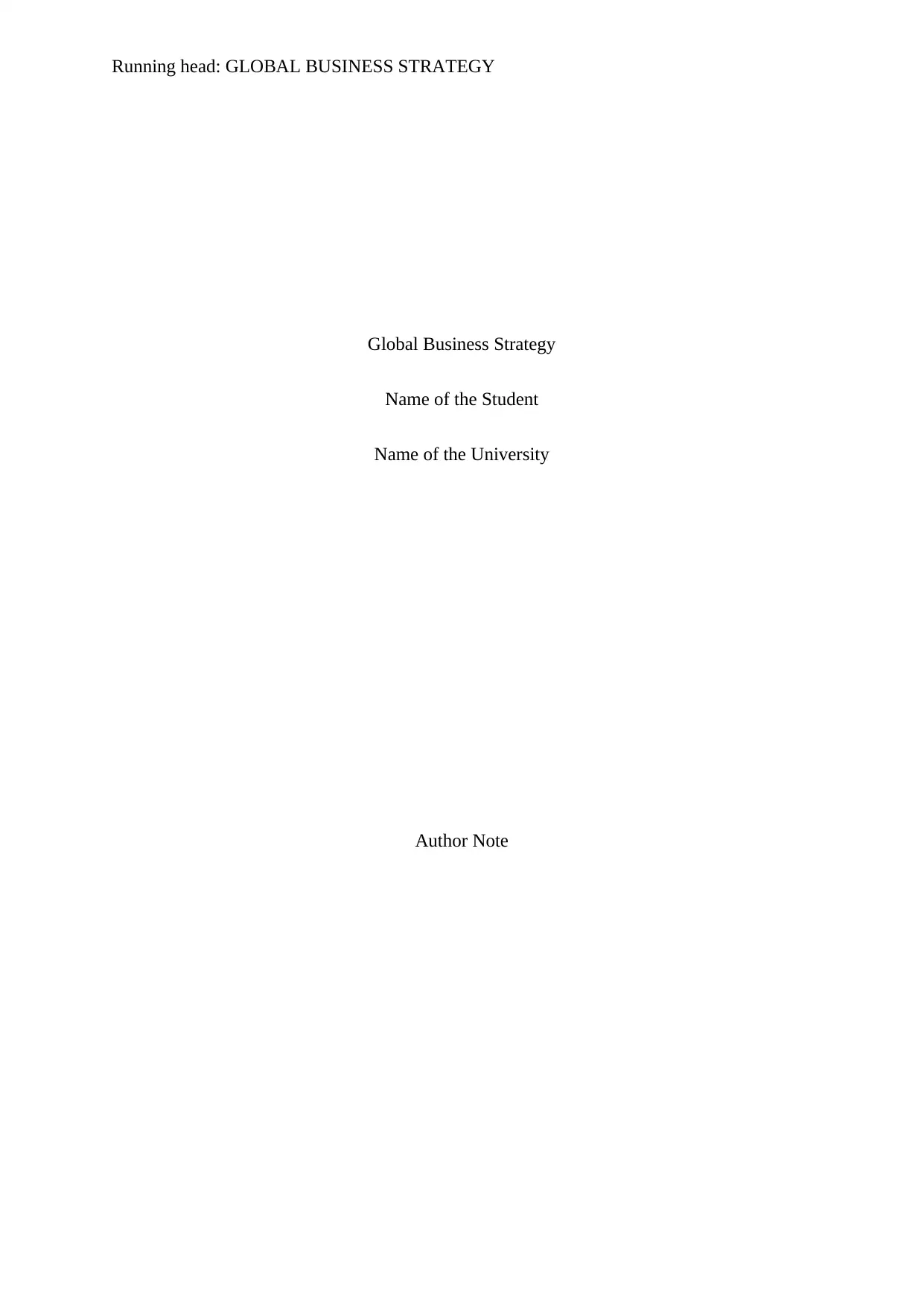
Running head: GLOBAL BUSINESS STRATEGY
Global Business Strategy
Name of the Student
Name of the University
Author Note
Global Business Strategy
Name of the Student
Name of the University
Author Note
Paraphrase This Document
Need a fresh take? Get an instant paraphrase of this document with our AI Paraphraser
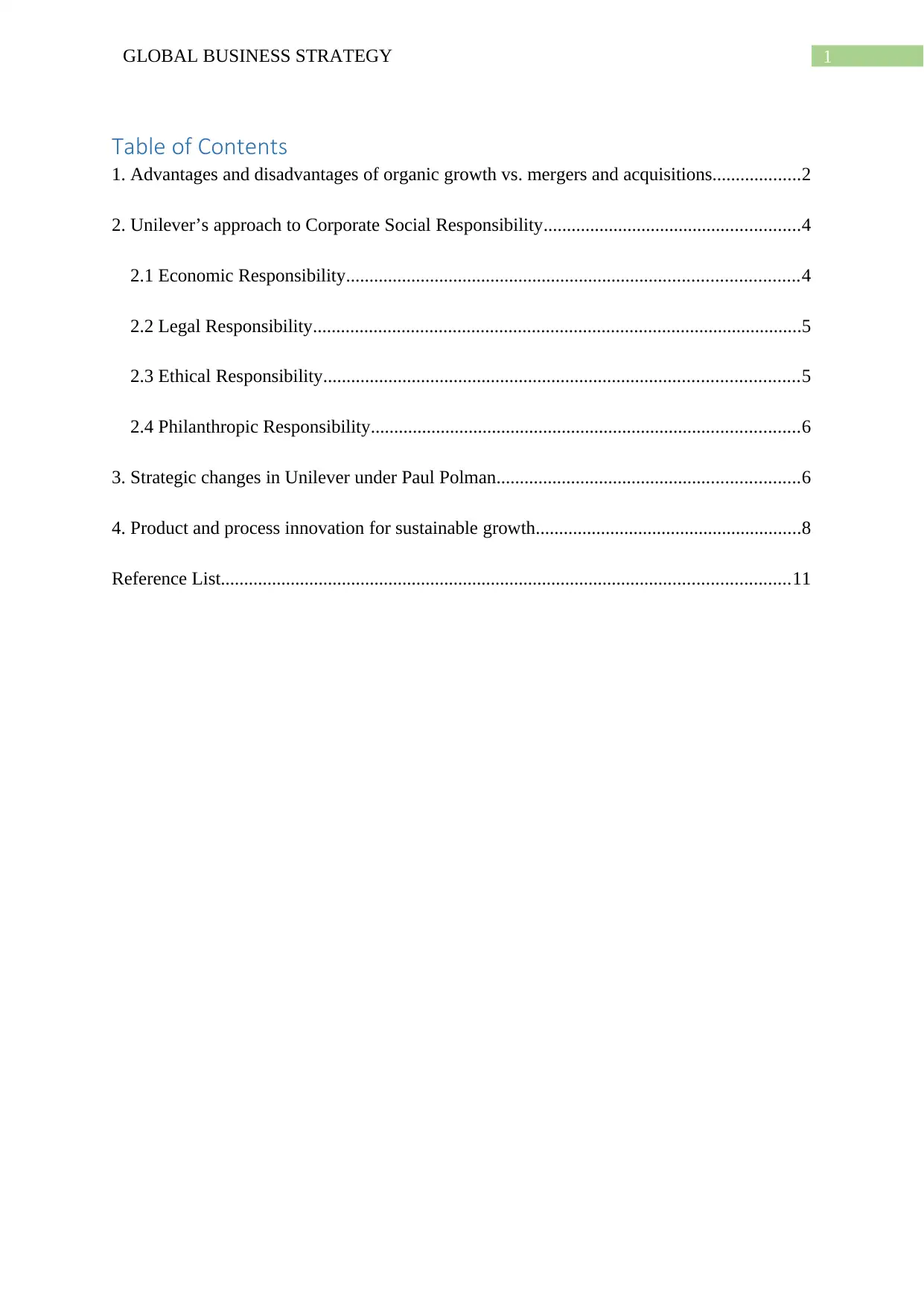
1GLOBAL BUSINESS STRATEGY
Table of Contents
1. Advantages and disadvantages of organic growth vs. mergers and acquisitions...................2
2. Unilever’s approach to Corporate Social Responsibility.......................................................4
2.1 Economic Responsibility.................................................................................................4
2.2 Legal Responsibility.........................................................................................................5
2.3 Ethical Responsibility......................................................................................................5
2.4 Philanthropic Responsibility............................................................................................6
3. Strategic changes in Unilever under Paul Polman.................................................................6
4. Product and process innovation for sustainable growth.........................................................8
Reference List..........................................................................................................................11
Table of Contents
1. Advantages and disadvantages of organic growth vs. mergers and acquisitions...................2
2. Unilever’s approach to Corporate Social Responsibility.......................................................4
2.1 Economic Responsibility.................................................................................................4
2.2 Legal Responsibility.........................................................................................................5
2.3 Ethical Responsibility......................................................................................................5
2.4 Philanthropic Responsibility............................................................................................6
3. Strategic changes in Unilever under Paul Polman.................................................................6
4. Product and process innovation for sustainable growth.........................................................8
Reference List..........................................................................................................................11
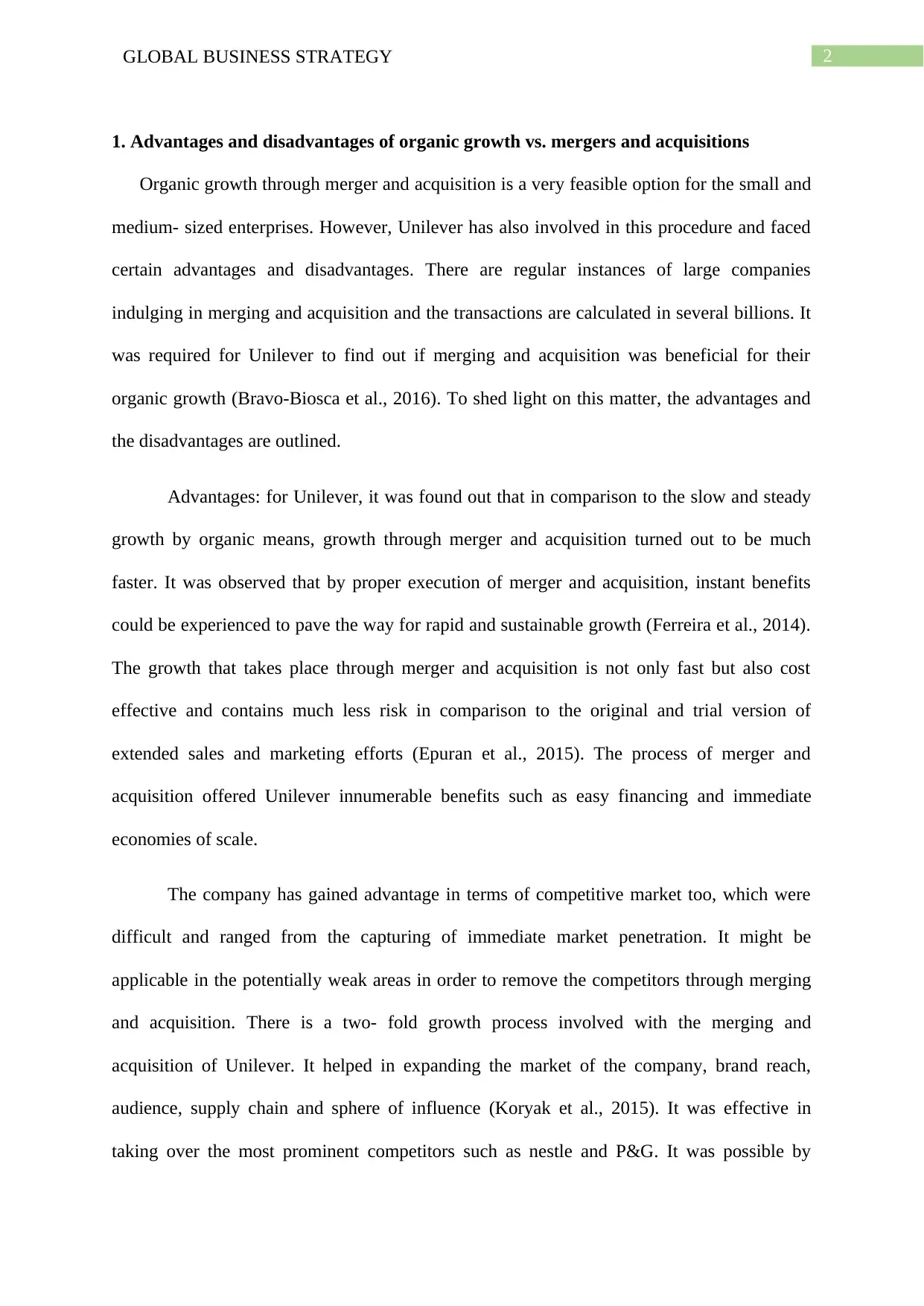
2GLOBAL BUSINESS STRATEGY
1. Advantages and disadvantages of organic growth vs. mergers and acquisitions
Organic growth through merger and acquisition is a very feasible option for the small and
medium- sized enterprises. However, Unilever has also involved in this procedure and faced
certain advantages and disadvantages. There are regular instances of large companies
indulging in merging and acquisition and the transactions are calculated in several billions. It
was required for Unilever to find out if merging and acquisition was beneficial for their
organic growth (Bravo-Biosca et al., 2016). To shed light on this matter, the advantages and
the disadvantages are outlined.
Advantages: for Unilever, it was found out that in comparison to the slow and steady
growth by organic means, growth through merger and acquisition turned out to be much
faster. It was observed that by proper execution of merger and acquisition, instant benefits
could be experienced to pave the way for rapid and sustainable growth (Ferreira et al., 2014).
The growth that takes place through merger and acquisition is not only fast but also cost
effective and contains much less risk in comparison to the original and trial version of
extended sales and marketing efforts (Epuran et al., 2015). The process of merger and
acquisition offered Unilever innumerable benefits such as easy financing and immediate
economies of scale.
The company has gained advantage in terms of competitive market too, which were
difficult and ranged from the capturing of immediate market penetration. It might be
applicable in the potentially weak areas in order to remove the competitors through merging
and acquisition. There is a two- fold growth process involved with the merging and
acquisition of Unilever. It helped in expanding the market of the company, brand reach,
audience, supply chain and sphere of influence (Koryak et al., 2015). It was effective in
taking over the most prominent competitors such as nestle and P&G. It was possible by
1. Advantages and disadvantages of organic growth vs. mergers and acquisitions
Organic growth through merger and acquisition is a very feasible option for the small and
medium- sized enterprises. However, Unilever has also involved in this procedure and faced
certain advantages and disadvantages. There are regular instances of large companies
indulging in merging and acquisition and the transactions are calculated in several billions. It
was required for Unilever to find out if merging and acquisition was beneficial for their
organic growth (Bravo-Biosca et al., 2016). To shed light on this matter, the advantages and
the disadvantages are outlined.
Advantages: for Unilever, it was found out that in comparison to the slow and steady
growth by organic means, growth through merger and acquisition turned out to be much
faster. It was observed that by proper execution of merger and acquisition, instant benefits
could be experienced to pave the way for rapid and sustainable growth (Ferreira et al., 2014).
The growth that takes place through merger and acquisition is not only fast but also cost
effective and contains much less risk in comparison to the original and trial version of
extended sales and marketing efforts (Epuran et al., 2015). The process of merger and
acquisition offered Unilever innumerable benefits such as easy financing and immediate
economies of scale.
The company has gained advantage in terms of competitive market too, which were
difficult and ranged from the capturing of immediate market penetration. It might be
applicable in the potentially weak areas in order to remove the competitors through merging
and acquisition. There is a two- fold growth process involved with the merging and
acquisition of Unilever. It helped in expanding the market of the company, brand reach,
audience, supply chain and sphere of influence (Koryak et al., 2015). It was effective in
taking over the most prominent competitors such as nestle and P&G. It was possible by
⊘ This is a preview!⊘
Do you want full access?
Subscribe today to unlock all pages.

Trusted by 1+ million students worldwide
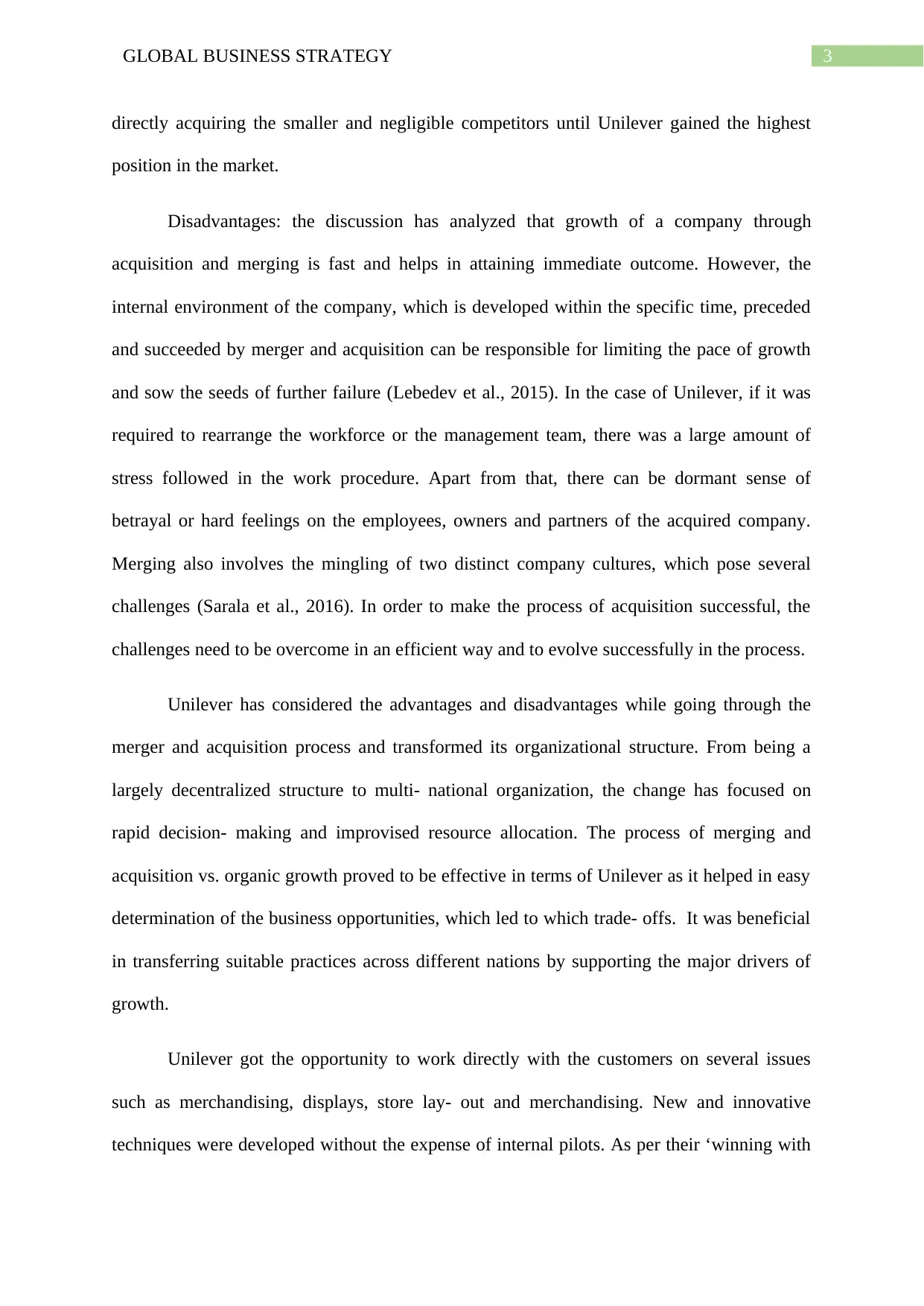
3GLOBAL BUSINESS STRATEGY
directly acquiring the smaller and negligible competitors until Unilever gained the highest
position in the market.
Disadvantages: the discussion has analyzed that growth of a company through
acquisition and merging is fast and helps in attaining immediate outcome. However, the
internal environment of the company, which is developed within the specific time, preceded
and succeeded by merger and acquisition can be responsible for limiting the pace of growth
and sow the seeds of further failure (Lebedev et al., 2015). In the case of Unilever, if it was
required to rearrange the workforce or the management team, there was a large amount of
stress followed in the work procedure. Apart from that, there can be dormant sense of
betrayal or hard feelings on the employees, owners and partners of the acquired company.
Merging also involves the mingling of two distinct company cultures, which pose several
challenges (Sarala et al., 2016). In order to make the process of acquisition successful, the
challenges need to be overcome in an efficient way and to evolve successfully in the process.
Unilever has considered the advantages and disadvantages while going through the
merger and acquisition process and transformed its organizational structure. From being a
largely decentralized structure to multi- national organization, the change has focused on
rapid decision- making and improvised resource allocation. The process of merging and
acquisition vs. organic growth proved to be effective in terms of Unilever as it helped in easy
determination of the business opportunities, which led to which trade- offs. It was beneficial
in transferring suitable practices across different nations by supporting the major drivers of
growth.
Unilever got the opportunity to work directly with the customers on several issues
such as merchandising, displays, store lay- out and merchandising. New and innovative
techniques were developed without the expense of internal pilots. As per their ‘winning with
directly acquiring the smaller and negligible competitors until Unilever gained the highest
position in the market.
Disadvantages: the discussion has analyzed that growth of a company through
acquisition and merging is fast and helps in attaining immediate outcome. However, the
internal environment of the company, which is developed within the specific time, preceded
and succeeded by merger and acquisition can be responsible for limiting the pace of growth
and sow the seeds of further failure (Lebedev et al., 2015). In the case of Unilever, if it was
required to rearrange the workforce or the management team, there was a large amount of
stress followed in the work procedure. Apart from that, there can be dormant sense of
betrayal or hard feelings on the employees, owners and partners of the acquired company.
Merging also involves the mingling of two distinct company cultures, which pose several
challenges (Sarala et al., 2016). In order to make the process of acquisition successful, the
challenges need to be overcome in an efficient way and to evolve successfully in the process.
Unilever has considered the advantages and disadvantages while going through the
merger and acquisition process and transformed its organizational structure. From being a
largely decentralized structure to multi- national organization, the change has focused on
rapid decision- making and improvised resource allocation. The process of merging and
acquisition vs. organic growth proved to be effective in terms of Unilever as it helped in easy
determination of the business opportunities, which led to which trade- offs. It was beneficial
in transferring suitable practices across different nations by supporting the major drivers of
growth.
Unilever got the opportunity to work directly with the customers on several issues
such as merchandising, displays, store lay- out and merchandising. New and innovative
techniques were developed without the expense of internal pilots. As per their ‘winning with
Paraphrase This Document
Need a fresh take? Get an instant paraphrase of this document with our AI Paraphraser
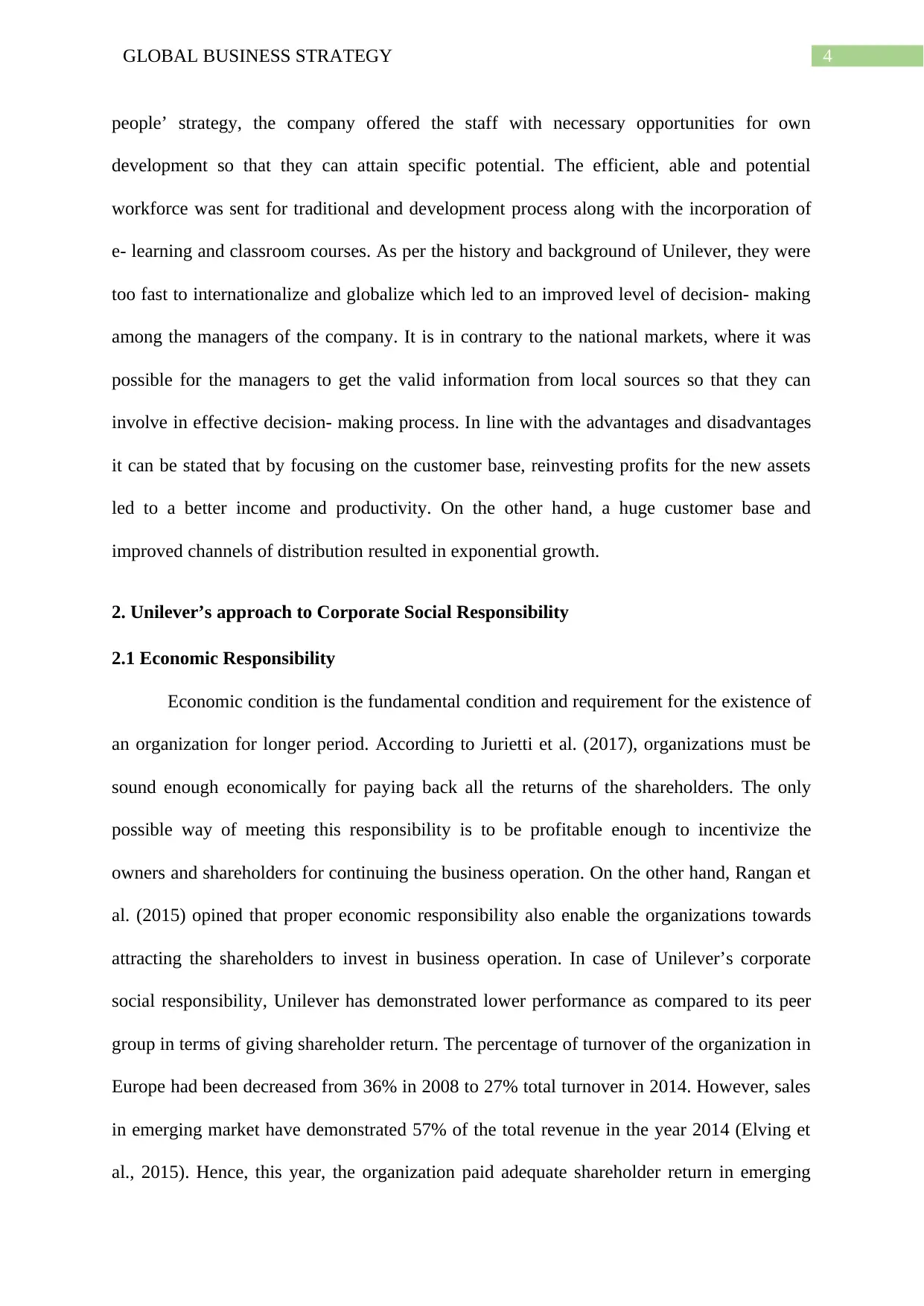
4GLOBAL BUSINESS STRATEGY
people’ strategy, the company offered the staff with necessary opportunities for own
development so that they can attain specific potential. The efficient, able and potential
workforce was sent for traditional and development process along with the incorporation of
e- learning and classroom courses. As per the history and background of Unilever, they were
too fast to internationalize and globalize which led to an improved level of decision- making
among the managers of the company. It is in contrary to the national markets, where it was
possible for the managers to get the valid information from local sources so that they can
involve in effective decision- making process. In line with the advantages and disadvantages
it can be stated that by focusing on the customer base, reinvesting profits for the new assets
led to a better income and productivity. On the other hand, a huge customer base and
improved channels of distribution resulted in exponential growth.
2. Unilever’s approach to Corporate Social Responsibility
2.1 Economic Responsibility
Economic condition is the fundamental condition and requirement for the existence of
an organization for longer period. According to Jurietti et al. (2017), organizations must be
sound enough economically for paying back all the returns of the shareholders. The only
possible way of meeting this responsibility is to be profitable enough to incentivize the
owners and shareholders for continuing the business operation. On the other hand, Rangan et
al. (2015) opined that proper economic responsibility also enable the organizations towards
attracting the shareholders to invest in business operation. In case of Unilever’s corporate
social responsibility, Unilever has demonstrated lower performance as compared to its peer
group in terms of giving shareholder return. The percentage of turnover of the organization in
Europe had been decreased from 36% in 2008 to 27% total turnover in 2014. However, sales
in emerging market have demonstrated 57% of the total revenue in the year 2014 (Elving et
al., 2015). Hence, this year, the organization paid adequate shareholder return in emerging
people’ strategy, the company offered the staff with necessary opportunities for own
development so that they can attain specific potential. The efficient, able and potential
workforce was sent for traditional and development process along with the incorporation of
e- learning and classroom courses. As per the history and background of Unilever, they were
too fast to internationalize and globalize which led to an improved level of decision- making
among the managers of the company. It is in contrary to the national markets, where it was
possible for the managers to get the valid information from local sources so that they can
involve in effective decision- making process. In line with the advantages and disadvantages
it can be stated that by focusing on the customer base, reinvesting profits for the new assets
led to a better income and productivity. On the other hand, a huge customer base and
improved channels of distribution resulted in exponential growth.
2. Unilever’s approach to Corporate Social Responsibility
2.1 Economic Responsibility
Economic condition is the fundamental condition and requirement for the existence of
an organization for longer period. According to Jurietti et al. (2017), organizations must be
sound enough economically for paying back all the returns of the shareholders. The only
possible way of meeting this responsibility is to be profitable enough to incentivize the
owners and shareholders for continuing the business operation. On the other hand, Rangan et
al. (2015) opined that proper economic responsibility also enable the organizations towards
attracting the shareholders to invest in business operation. In case of Unilever’s corporate
social responsibility, Unilever has demonstrated lower performance as compared to its peer
group in terms of giving shareholder return. The percentage of turnover of the organization in
Europe had been decreased from 36% in 2008 to 27% total turnover in 2014. However, sales
in emerging market have demonstrated 57% of the total revenue in the year 2014 (Elving et
al., 2015). Hence, this year, the organization paid adequate shareholder return in emerging
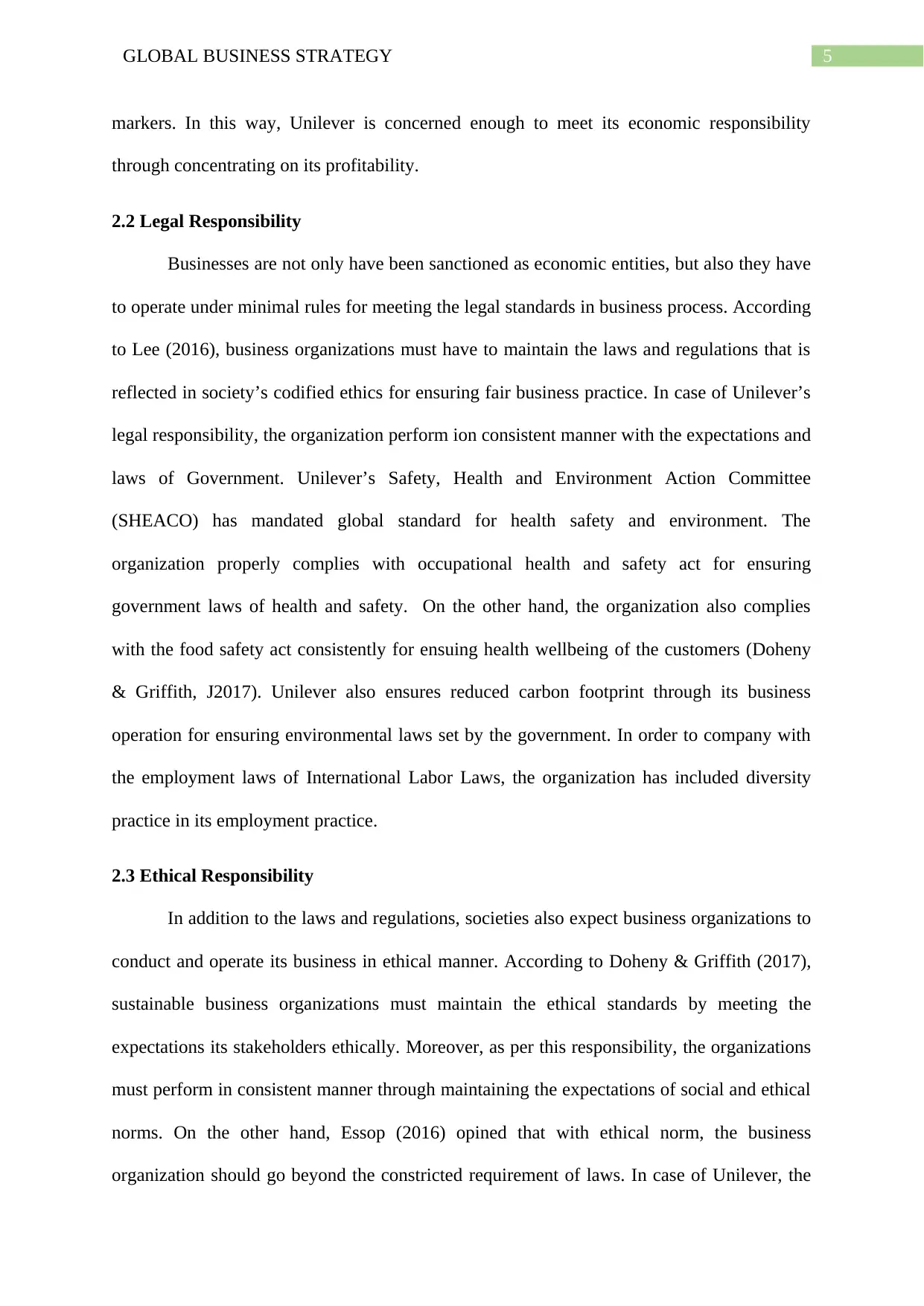
5GLOBAL BUSINESS STRATEGY
markers. In this way, Unilever is concerned enough to meet its economic responsibility
through concentrating on its profitability.
2.2 Legal Responsibility
Businesses are not only have been sanctioned as economic entities, but also they have
to operate under minimal rules for meeting the legal standards in business process. According
to Lee (2016), business organizations must have to maintain the laws and regulations that is
reflected in society’s codified ethics for ensuring fair business practice. In case of Unilever’s
legal responsibility, the organization perform ion consistent manner with the expectations and
laws of Government. Unilever’s Safety, Health and Environment Action Committee
(SHEACO) has mandated global standard for health safety and environment. The
organization properly complies with occupational health and safety act for ensuring
government laws of health and safety. On the other hand, the organization also complies
with the food safety act consistently for ensuing health wellbeing of the customers (Doheny
& Griffith, J2017). Unilever also ensures reduced carbon footprint through its business
operation for ensuring environmental laws set by the government. In order to company with
the employment laws of International Labor Laws, the organization has included diversity
practice in its employment practice.
2.3 Ethical Responsibility
In addition to the laws and regulations, societies also expect business organizations to
conduct and operate its business in ethical manner. According to Doheny & Griffith (2017),
sustainable business organizations must maintain the ethical standards by meeting the
expectations its stakeholders ethically. Moreover, as per this responsibility, the organizations
must perform in consistent manner through maintaining the expectations of social and ethical
norms. On the other hand, Essop (2016) opined that with ethical norm, the business
organization should go beyond the constricted requirement of laws. In case of Unilever, the
markers. In this way, Unilever is concerned enough to meet its economic responsibility
through concentrating on its profitability.
2.2 Legal Responsibility
Businesses are not only have been sanctioned as economic entities, but also they have
to operate under minimal rules for meeting the legal standards in business process. According
to Lee (2016), business organizations must have to maintain the laws and regulations that is
reflected in society’s codified ethics for ensuring fair business practice. In case of Unilever’s
legal responsibility, the organization perform ion consistent manner with the expectations and
laws of Government. Unilever’s Safety, Health and Environment Action Committee
(SHEACO) has mandated global standard for health safety and environment. The
organization properly complies with occupational health and safety act for ensuring
government laws of health and safety. On the other hand, the organization also complies
with the food safety act consistently for ensuing health wellbeing of the customers (Doheny
& Griffith, J2017). Unilever also ensures reduced carbon footprint through its business
operation for ensuring environmental laws set by the government. In order to company with
the employment laws of International Labor Laws, the organization has included diversity
practice in its employment practice.
2.3 Ethical Responsibility
In addition to the laws and regulations, societies also expect business organizations to
conduct and operate its business in ethical manner. According to Doheny & Griffith (2017),
sustainable business organizations must maintain the ethical standards by meeting the
expectations its stakeholders ethically. Moreover, as per this responsibility, the organizations
must perform in consistent manner through maintaining the expectations of social and ethical
norms. On the other hand, Essop (2016) opined that with ethical norm, the business
organization should go beyond the constricted requirement of laws. In case of Unilever, the
⊘ This is a preview!⊘
Do you want full access?
Subscribe today to unlock all pages.

Trusted by 1+ million students worldwide
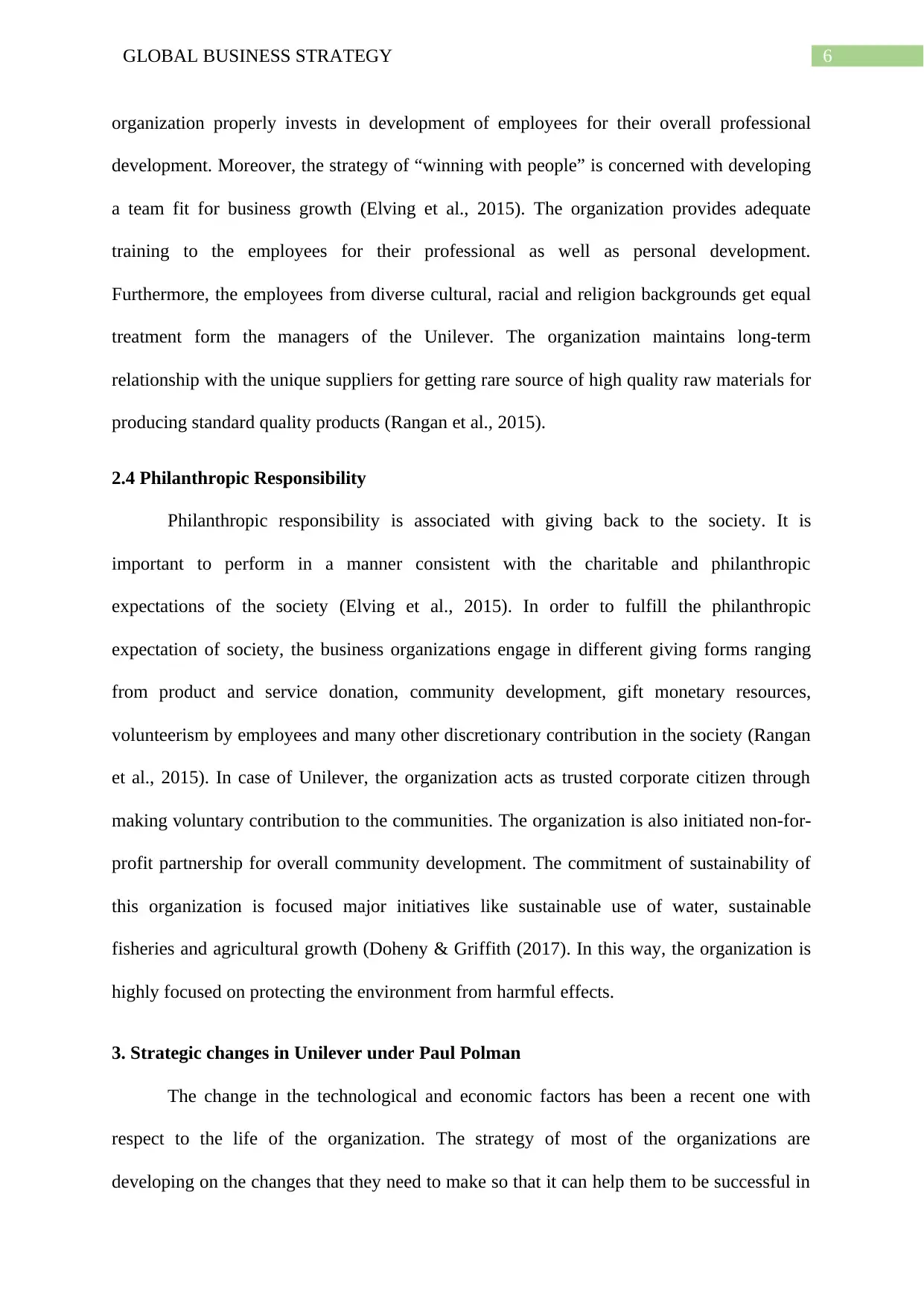
6GLOBAL BUSINESS STRATEGY
organization properly invests in development of employees for their overall professional
development. Moreover, the strategy of “winning with people” is concerned with developing
a team fit for business growth (Elving et al., 2015). The organization provides adequate
training to the employees for their professional as well as personal development.
Furthermore, the employees from diverse cultural, racial and religion backgrounds get equal
treatment form the managers of the Unilever. The organization maintains long-term
relationship with the unique suppliers for getting rare source of high quality raw materials for
producing standard quality products (Rangan et al., 2015).
2.4 Philanthropic Responsibility
Philanthropic responsibility is associated with giving back to the society. It is
important to perform in a manner consistent with the charitable and philanthropic
expectations of the society (Elving et al., 2015). In order to fulfill the philanthropic
expectation of society, the business organizations engage in different giving forms ranging
from product and service donation, community development, gift monetary resources,
volunteerism by employees and many other discretionary contribution in the society (Rangan
et al., 2015). In case of Unilever, the organization acts as trusted corporate citizen through
making voluntary contribution to the communities. The organization is also initiated non-for-
profit partnership for overall community development. The commitment of sustainability of
this organization is focused major initiatives like sustainable use of water, sustainable
fisheries and agricultural growth (Doheny & Griffith (2017). In this way, the organization is
highly focused on protecting the environment from harmful effects.
3. Strategic changes in Unilever under Paul Polman
The change in the technological and economic factors has been a recent one with
respect to the life of the organization. The strategy of most of the organizations are
developing on the changes that they need to make so that it can help them to be successful in
organization properly invests in development of employees for their overall professional
development. Moreover, the strategy of “winning with people” is concerned with developing
a team fit for business growth (Elving et al., 2015). The organization provides adequate
training to the employees for their professional as well as personal development.
Furthermore, the employees from diverse cultural, racial and religion backgrounds get equal
treatment form the managers of the Unilever. The organization maintains long-term
relationship with the unique suppliers for getting rare source of high quality raw materials for
producing standard quality products (Rangan et al., 2015).
2.4 Philanthropic Responsibility
Philanthropic responsibility is associated with giving back to the society. It is
important to perform in a manner consistent with the charitable and philanthropic
expectations of the society (Elving et al., 2015). In order to fulfill the philanthropic
expectation of society, the business organizations engage in different giving forms ranging
from product and service donation, community development, gift monetary resources,
volunteerism by employees and many other discretionary contribution in the society (Rangan
et al., 2015). In case of Unilever, the organization acts as trusted corporate citizen through
making voluntary contribution to the communities. The organization is also initiated non-for-
profit partnership for overall community development. The commitment of sustainability of
this organization is focused major initiatives like sustainable use of water, sustainable
fisheries and agricultural growth (Doheny & Griffith (2017). In this way, the organization is
highly focused on protecting the environment from harmful effects.
3. Strategic changes in Unilever under Paul Polman
The change in the technological and economic factors has been a recent one with
respect to the life of the organization. The strategy of most of the organizations are
developing on the changes that they need to make so that it can help them to be successful in
Paraphrase This Document
Need a fresh take? Get an instant paraphrase of this document with our AI Paraphraser
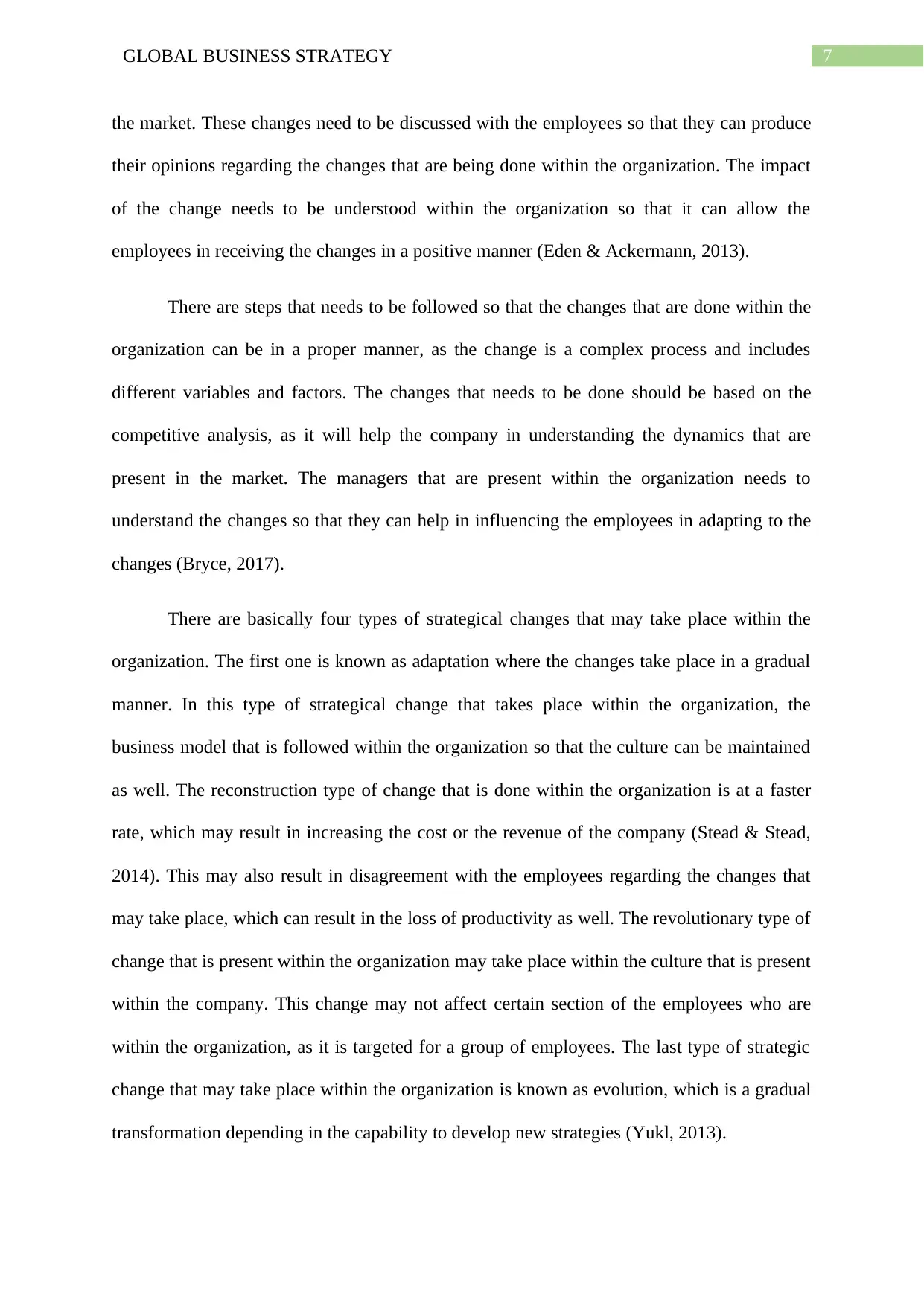
7GLOBAL BUSINESS STRATEGY
the market. These changes need to be discussed with the employees so that they can produce
their opinions regarding the changes that are being done within the organization. The impact
of the change needs to be understood within the organization so that it can allow the
employees in receiving the changes in a positive manner (Eden & Ackermann, 2013).
There are steps that needs to be followed so that the changes that are done within the
organization can be in a proper manner, as the change is a complex process and includes
different variables and factors. The changes that needs to be done should be based on the
competitive analysis, as it will help the company in understanding the dynamics that are
present in the market. The managers that are present within the organization needs to
understand the changes so that they can help in influencing the employees in adapting to the
changes (Bryce, 2017).
There are basically four types of strategical changes that may take place within the
organization. The first one is known as adaptation where the changes take place in a gradual
manner. In this type of strategical change that takes place within the organization, the
business model that is followed within the organization so that the culture can be maintained
as well. The reconstruction type of change that is done within the organization is at a faster
rate, which may result in increasing the cost or the revenue of the company (Stead & Stead,
2014). This may also result in disagreement with the employees regarding the changes that
may take place, which can result in the loss of productivity as well. The revolutionary type of
change that is present within the organization may take place within the culture that is present
within the company. This change may not affect certain section of the employees who are
within the organization, as it is targeted for a group of employees. The last type of strategic
change that may take place within the organization is known as evolution, which is a gradual
transformation depending in the capability to develop new strategies (Yukl, 2013).
the market. These changes need to be discussed with the employees so that they can produce
their opinions regarding the changes that are being done within the organization. The impact
of the change needs to be understood within the organization so that it can allow the
employees in receiving the changes in a positive manner (Eden & Ackermann, 2013).
There are steps that needs to be followed so that the changes that are done within the
organization can be in a proper manner, as the change is a complex process and includes
different variables and factors. The changes that needs to be done should be based on the
competitive analysis, as it will help the company in understanding the dynamics that are
present in the market. The managers that are present within the organization needs to
understand the changes so that they can help in influencing the employees in adapting to the
changes (Bryce, 2017).
There are basically four types of strategical changes that may take place within the
organization. The first one is known as adaptation where the changes take place in a gradual
manner. In this type of strategical change that takes place within the organization, the
business model that is followed within the organization so that the culture can be maintained
as well. The reconstruction type of change that is done within the organization is at a faster
rate, which may result in increasing the cost or the revenue of the company (Stead & Stead,
2014). This may also result in disagreement with the employees regarding the changes that
may take place, which can result in the loss of productivity as well. The revolutionary type of
change that is present within the organization may take place within the culture that is present
within the company. This change may not affect certain section of the employees who are
within the organization, as it is targeted for a group of employees. The last type of strategic
change that may take place within the organization is known as evolution, which is a gradual
transformation depending in the capability to develop new strategies (Yukl, 2013).
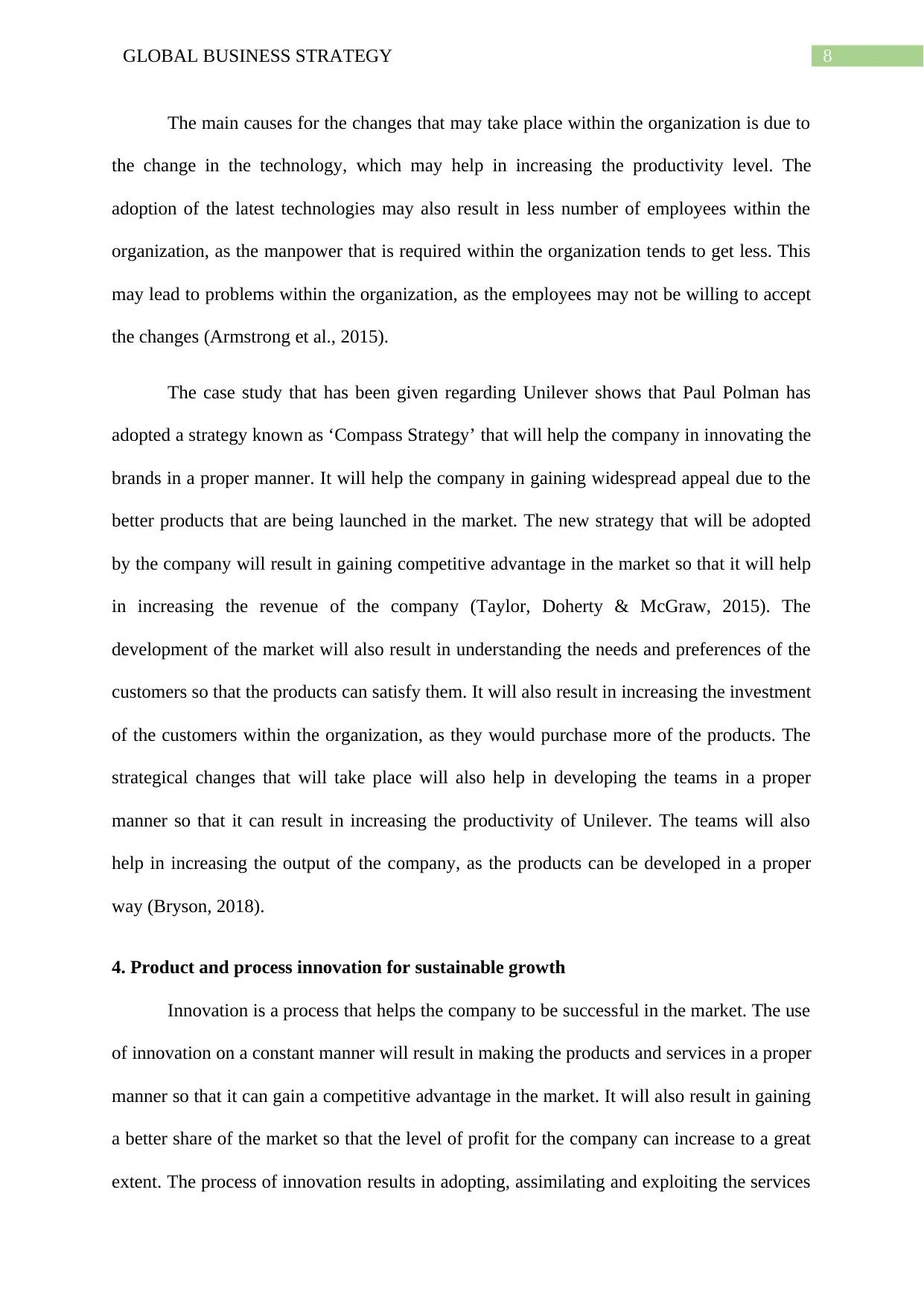
8GLOBAL BUSINESS STRATEGY
The main causes for the changes that may take place within the organization is due to
the change in the technology, which may help in increasing the productivity level. The
adoption of the latest technologies may also result in less number of employees within the
organization, as the manpower that is required within the organization tends to get less. This
may lead to problems within the organization, as the employees may not be willing to accept
the changes (Armstrong et al., 2015).
The case study that has been given regarding Unilever shows that Paul Polman has
adopted a strategy known as ‘Compass Strategy’ that will help the company in innovating the
brands in a proper manner. It will help the company in gaining widespread appeal due to the
better products that are being launched in the market. The new strategy that will be adopted
by the company will result in gaining competitive advantage in the market so that it will help
in increasing the revenue of the company (Taylor, Doherty & McGraw, 2015). The
development of the market will also result in understanding the needs and preferences of the
customers so that the products can satisfy them. It will also result in increasing the investment
of the customers within the organization, as they would purchase more of the products. The
strategical changes that will take place will also help in developing the teams in a proper
manner so that it can result in increasing the productivity of Unilever. The teams will also
help in increasing the output of the company, as the products can be developed in a proper
way (Bryson, 2018).
4. Product and process innovation for sustainable growth
Innovation is a process that helps the company to be successful in the market. The use
of innovation on a constant manner will result in making the products and services in a proper
manner so that it can gain a competitive advantage in the market. It will also result in gaining
a better share of the market so that the level of profit for the company can increase to a great
extent. The process of innovation results in adopting, assimilating and exploiting the services
The main causes for the changes that may take place within the organization is due to
the change in the technology, which may help in increasing the productivity level. The
adoption of the latest technologies may also result in less number of employees within the
organization, as the manpower that is required within the organization tends to get less. This
may lead to problems within the organization, as the employees may not be willing to accept
the changes (Armstrong et al., 2015).
The case study that has been given regarding Unilever shows that Paul Polman has
adopted a strategy known as ‘Compass Strategy’ that will help the company in innovating the
brands in a proper manner. It will help the company in gaining widespread appeal due to the
better products that are being launched in the market. The new strategy that will be adopted
by the company will result in gaining competitive advantage in the market so that it will help
in increasing the revenue of the company (Taylor, Doherty & McGraw, 2015). The
development of the market will also result in understanding the needs and preferences of the
customers so that the products can satisfy them. It will also result in increasing the investment
of the customers within the organization, as they would purchase more of the products. The
strategical changes that will take place will also help in developing the teams in a proper
manner so that it can result in increasing the productivity of Unilever. The teams will also
help in increasing the output of the company, as the products can be developed in a proper
way (Bryson, 2018).
4. Product and process innovation for sustainable growth
Innovation is a process that helps the company to be successful in the market. The use
of innovation on a constant manner will result in making the products and services in a proper
manner so that it can gain a competitive advantage in the market. It will also result in gaining
a better share of the market so that the level of profit for the company can increase to a great
extent. The process of innovation results in adopting, assimilating and exploiting the services
⊘ This is a preview!⊘
Do you want full access?
Subscribe today to unlock all pages.

Trusted by 1+ million students worldwide
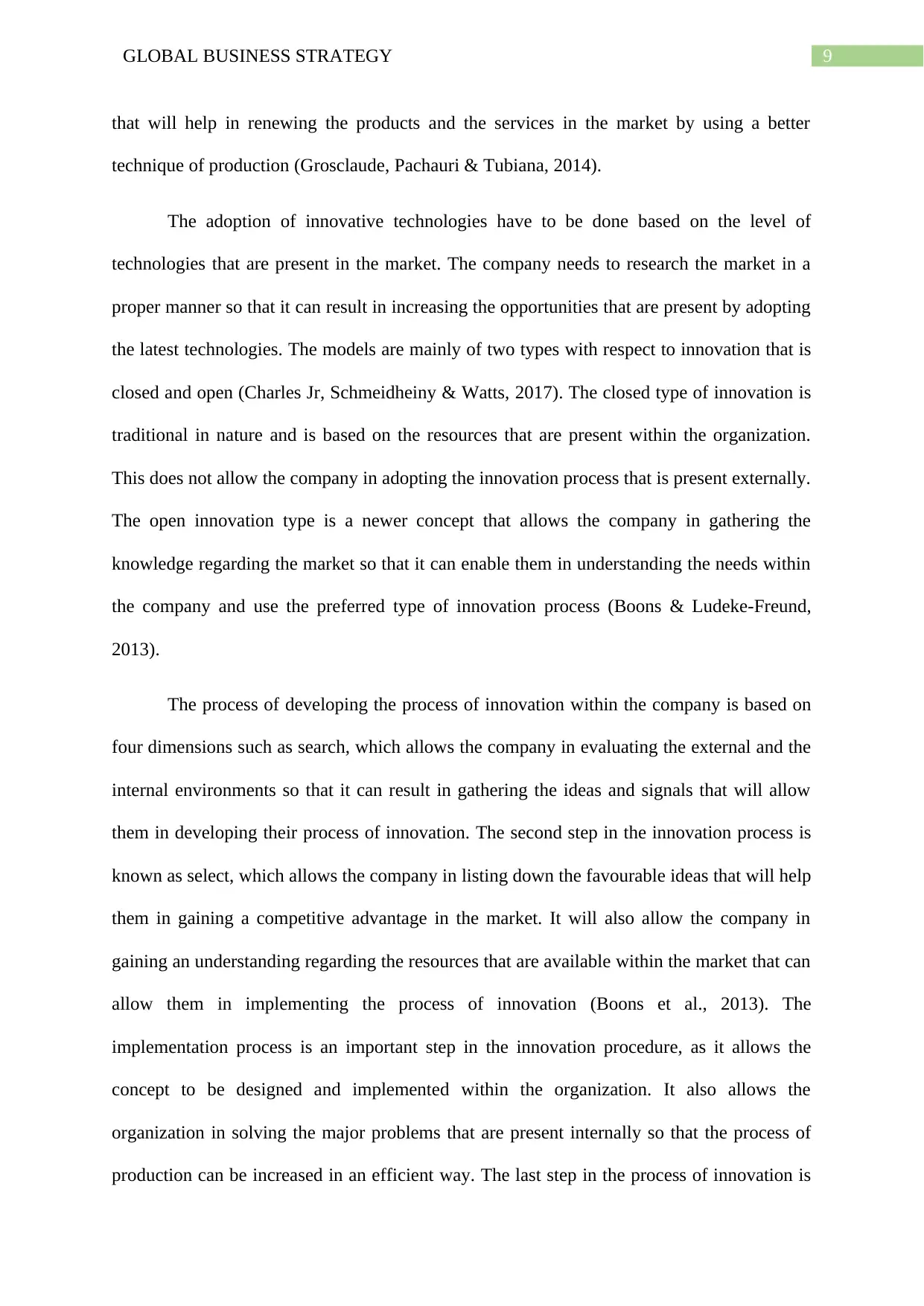
9GLOBAL BUSINESS STRATEGY
that will help in renewing the products and the services in the market by using a better
technique of production (Grosclaude, Pachauri & Tubiana, 2014).
The adoption of innovative technologies have to be done based on the level of
technologies that are present in the market. The company needs to research the market in a
proper manner so that it can result in increasing the opportunities that are present by adopting
the latest technologies. The models are mainly of two types with respect to innovation that is
closed and open (Charles Jr, Schmeidheiny & Watts, 2017). The closed type of innovation is
traditional in nature and is based on the resources that are present within the organization.
This does not allow the company in adopting the innovation process that is present externally.
The open innovation type is a newer concept that allows the company in gathering the
knowledge regarding the market so that it can enable them in understanding the needs within
the company and use the preferred type of innovation process (Boons & Ludeke-Freund,
2013).
The process of developing the process of innovation within the company is based on
four dimensions such as search, which allows the company in evaluating the external and the
internal environments so that it can result in gathering the ideas and signals that will allow
them in developing their process of innovation. The second step in the innovation process is
known as select, which allows the company in listing down the favourable ideas that will help
them in gaining a competitive advantage in the market. It will also allow the company in
gaining an understanding regarding the resources that are available within the market that can
allow them in implementing the process of innovation (Boons et al., 2013). The
implementation process is an important step in the innovation procedure, as it allows the
concept to be designed and implemented within the organization. It also allows the
organization in solving the major problems that are present internally so that the process of
production can be increased in an efficient way. The last step in the process of innovation is
that will help in renewing the products and the services in the market by using a better
technique of production (Grosclaude, Pachauri & Tubiana, 2014).
The adoption of innovative technologies have to be done based on the level of
technologies that are present in the market. The company needs to research the market in a
proper manner so that it can result in increasing the opportunities that are present by adopting
the latest technologies. The models are mainly of two types with respect to innovation that is
closed and open (Charles Jr, Schmeidheiny & Watts, 2017). The closed type of innovation is
traditional in nature and is based on the resources that are present within the organization.
This does not allow the company in adopting the innovation process that is present externally.
The open innovation type is a newer concept that allows the company in gathering the
knowledge regarding the market so that it can enable them in understanding the needs within
the company and use the preferred type of innovation process (Boons & Ludeke-Freund,
2013).
The process of developing the process of innovation within the company is based on
four dimensions such as search, which allows the company in evaluating the external and the
internal environments so that it can result in gathering the ideas and signals that will allow
them in developing their process of innovation. The second step in the innovation process is
known as select, which allows the company in listing down the favourable ideas that will help
them in gaining a competitive advantage in the market. It will also allow the company in
gaining an understanding regarding the resources that are available within the market that can
allow them in implementing the process of innovation (Boons et al., 2013). The
implementation process is an important step in the innovation procedure, as it allows the
concept to be designed and implemented within the organization. It also allows the
organization in solving the major problems that are present internally so that the process of
production can be increased in an efficient way. The last step in the process of innovation is
Paraphrase This Document
Need a fresh take? Get an instant paraphrase of this document with our AI Paraphraser
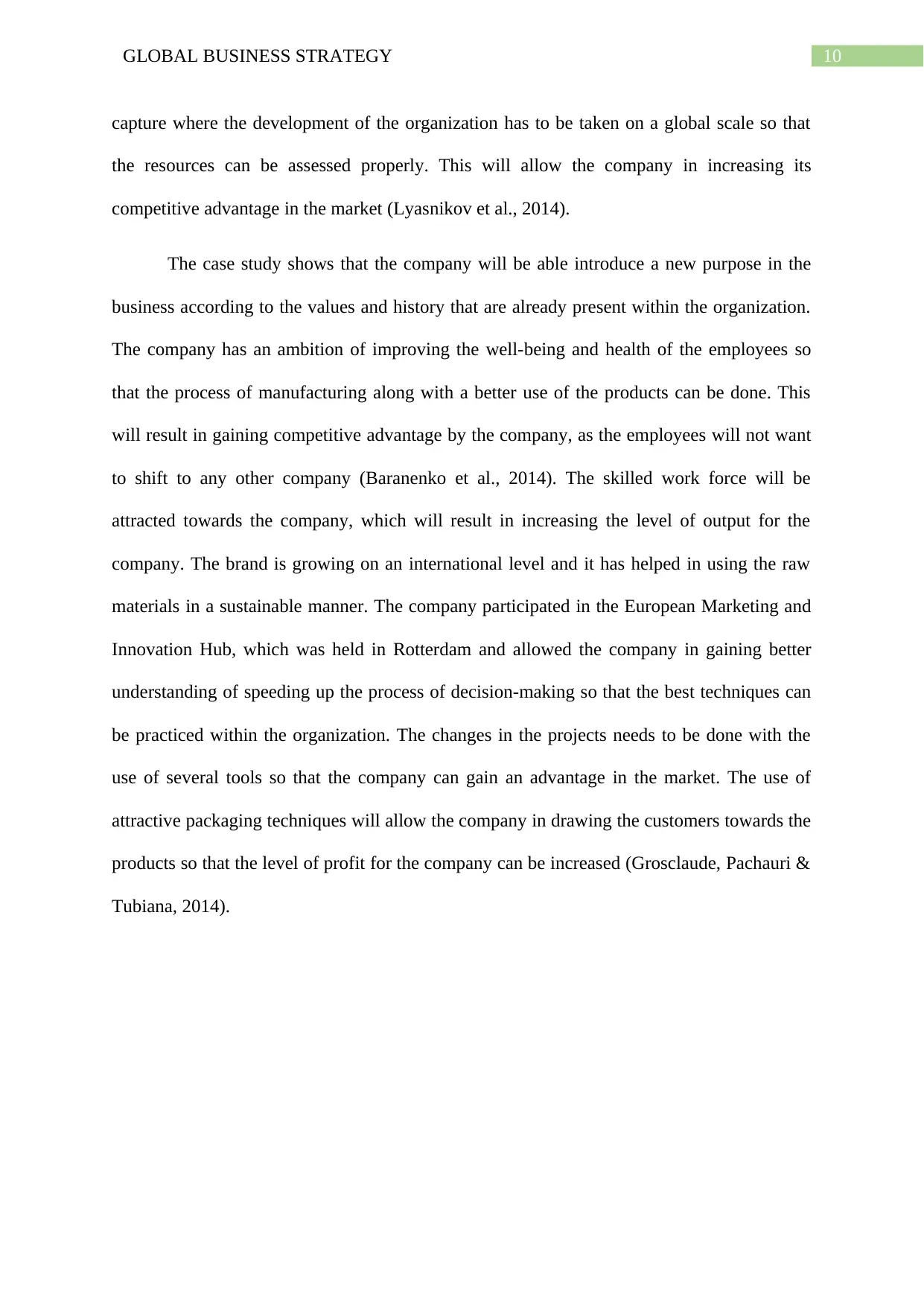
10GLOBAL BUSINESS STRATEGY
capture where the development of the organization has to be taken on a global scale so that
the resources can be assessed properly. This will allow the company in increasing its
competitive advantage in the market (Lyasnikov et al., 2014).
The case study shows that the company will be able introduce a new purpose in the
business according to the values and history that are already present within the organization.
The company has an ambition of improving the well-being and health of the employees so
that the process of manufacturing along with a better use of the products can be done. This
will result in gaining competitive advantage by the company, as the employees will not want
to shift to any other company (Baranenko et al., 2014). The skilled work force will be
attracted towards the company, which will result in increasing the level of output for the
company. The brand is growing on an international level and it has helped in using the raw
materials in a sustainable manner. The company participated in the European Marketing and
Innovation Hub, which was held in Rotterdam and allowed the company in gaining better
understanding of speeding up the process of decision-making so that the best techniques can
be practiced within the organization. The changes in the projects needs to be done with the
use of several tools so that the company can gain an advantage in the market. The use of
attractive packaging techniques will allow the company in drawing the customers towards the
products so that the level of profit for the company can be increased (Grosclaude, Pachauri &
Tubiana, 2014).
capture where the development of the organization has to be taken on a global scale so that
the resources can be assessed properly. This will allow the company in increasing its
competitive advantage in the market (Lyasnikov et al., 2014).
The case study shows that the company will be able introduce a new purpose in the
business according to the values and history that are already present within the organization.
The company has an ambition of improving the well-being and health of the employees so
that the process of manufacturing along with a better use of the products can be done. This
will result in gaining competitive advantage by the company, as the employees will not want
to shift to any other company (Baranenko et al., 2014). The skilled work force will be
attracted towards the company, which will result in increasing the level of output for the
company. The brand is growing on an international level and it has helped in using the raw
materials in a sustainable manner. The company participated in the European Marketing and
Innovation Hub, which was held in Rotterdam and allowed the company in gaining better
understanding of speeding up the process of decision-making so that the best techniques can
be practiced within the organization. The changes in the projects needs to be done with the
use of several tools so that the company can gain an advantage in the market. The use of
attractive packaging techniques will allow the company in drawing the customers towards the
products so that the level of profit for the company can be increased (Grosclaude, Pachauri &
Tubiana, 2014).
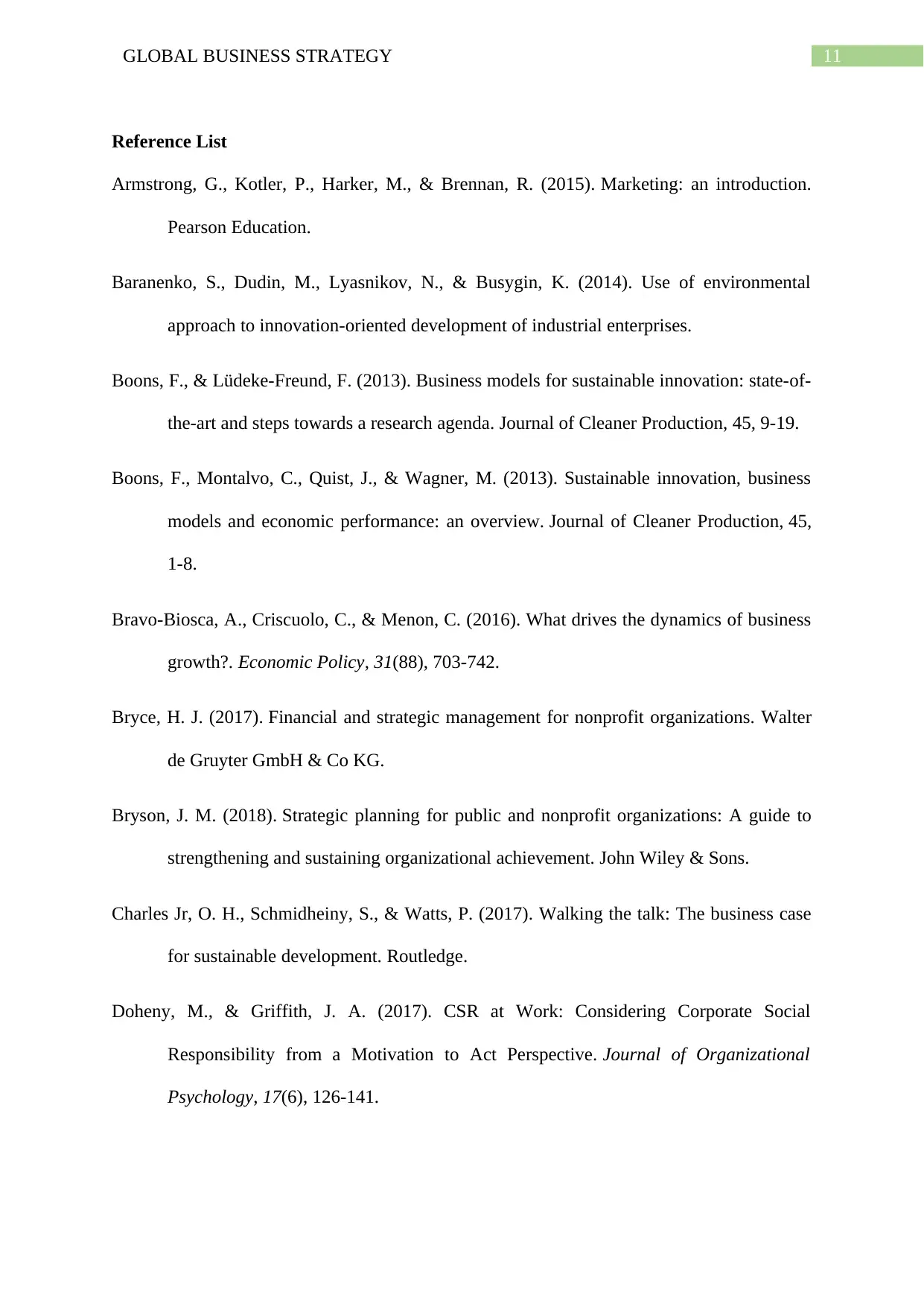
11GLOBAL BUSINESS STRATEGY
Reference List
Armstrong, G., Kotler, P., Harker, M., & Brennan, R. (2015). Marketing: an introduction.
Pearson Education.
Baranenko, S., Dudin, M., Lyasnikov, N., & Busygin, K. (2014). Use of environmental
approach to innovation-oriented development of industrial enterprises.
Boons, F., & Lüdeke-Freund, F. (2013). Business models for sustainable innovation: state-of-
the-art and steps towards a research agenda. Journal of Cleaner Production, 45, 9-19.
Boons, F., Montalvo, C., Quist, J., & Wagner, M. (2013). Sustainable innovation, business
models and economic performance: an overview. Journal of Cleaner Production, 45,
1-8.
Bravo-Biosca, A., Criscuolo, C., & Menon, C. (2016). What drives the dynamics of business
growth?. Economic Policy, 31(88), 703-742.
Bryce, H. J. (2017). Financial and strategic management for nonprofit organizations. Walter
de Gruyter GmbH & Co KG.
Bryson, J. M. (2018). Strategic planning for public and nonprofit organizations: A guide to
strengthening and sustaining organizational achievement. John Wiley & Sons.
Charles Jr, O. H., Schmidheiny, S., & Watts, P. (2017). Walking the talk: The business case
for sustainable development. Routledge.
Doheny, M., & Griffith, J. A. (2017). CSR at Work: Considering Corporate Social
Responsibility from a Motivation to Act Perspective. Journal of Organizational
Psychology, 17(6), 126-141.
Reference List
Armstrong, G., Kotler, P., Harker, M., & Brennan, R. (2015). Marketing: an introduction.
Pearson Education.
Baranenko, S., Dudin, M., Lyasnikov, N., & Busygin, K. (2014). Use of environmental
approach to innovation-oriented development of industrial enterprises.
Boons, F., & Lüdeke-Freund, F. (2013). Business models for sustainable innovation: state-of-
the-art and steps towards a research agenda. Journal of Cleaner Production, 45, 9-19.
Boons, F., Montalvo, C., Quist, J., & Wagner, M. (2013). Sustainable innovation, business
models and economic performance: an overview. Journal of Cleaner Production, 45,
1-8.
Bravo-Biosca, A., Criscuolo, C., & Menon, C. (2016). What drives the dynamics of business
growth?. Economic Policy, 31(88), 703-742.
Bryce, H. J. (2017). Financial and strategic management for nonprofit organizations. Walter
de Gruyter GmbH & Co KG.
Bryson, J. M. (2018). Strategic planning for public and nonprofit organizations: A guide to
strengthening and sustaining organizational achievement. John Wiley & Sons.
Charles Jr, O. H., Schmidheiny, S., & Watts, P. (2017). Walking the talk: The business case
for sustainable development. Routledge.
Doheny, M., & Griffith, J. A. (2017). CSR at Work: Considering Corporate Social
Responsibility from a Motivation to Act Perspective. Journal of Organizational
Psychology, 17(6), 126-141.
⊘ This is a preview!⊘
Do you want full access?
Subscribe today to unlock all pages.

Trusted by 1+ million students worldwide
1 out of 14
Related Documents
Your All-in-One AI-Powered Toolkit for Academic Success.
+13062052269
info@desklib.com
Available 24*7 on WhatsApp / Email
![[object Object]](/_next/static/media/star-bottom.7253800d.svg)
Unlock your academic potential
Copyright © 2020–2025 A2Z Services. All Rights Reserved. Developed and managed by ZUCOL.





